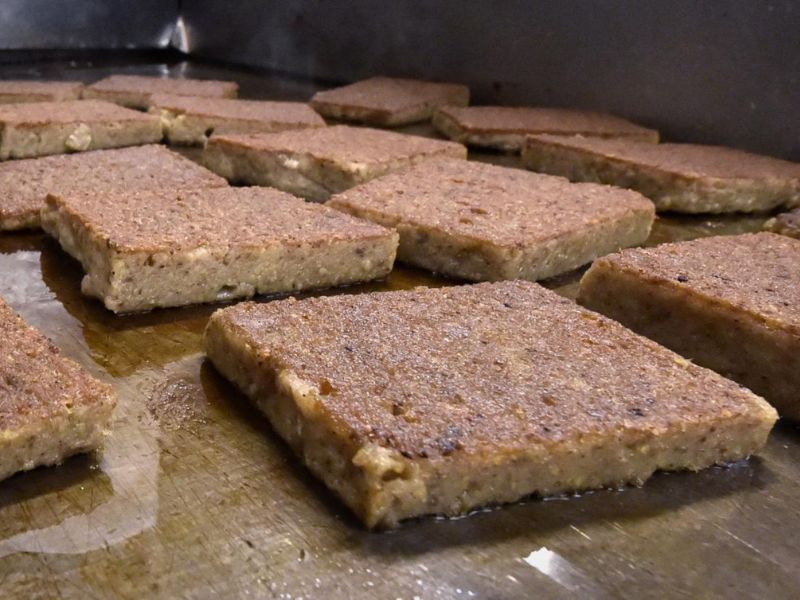Scrapple is a unique dish that has been enjoyed for generations in many parts of the world. It’s a type of sausage made from pork scraps and trimmings mixed with cornmeal, flour, and spices. Despite its humble origins, scrapple has a dedicated following of fans who appreciate its delicious, savory flavor and comforting texture.
However, many people are unsure about whether or not they can freeze scrapple, and if so, how to do it correctly. In this blog post, we’ll explore the composition of scrapple, the factors that affect its freezability, and how to properly freeze, thaw, and serve this dish.
What is Scrapple Made Of?
Scrapple is a type of sausage that’s made from pork scraps and trimmings. The main ingredients include pork scraps, cornmeal, flour, spices, and sometimes seasonings like sage and thyme. The ingredients are mixed together, cooked until they’re tender, and then formed into a loaf or slices that can be fried or baked.
There are many variations of scrapple, with different recipes and ingredients depending on the region. Some variations include beef scrapple, turkey scrapple, and even vegetarian scrapple made with soy or other plant-based proteins.
While scrapple may not be the healthiest dish, it does provide a source of protein, which is essential for a balanced diet.
Can You Freeze Scrapple?
Freezing scrapple is possible, but it’s important to understand that not all types of scrapple freeze equally well. Factors such as the moisture content, the type of ingredients used, and the preparation method all play a role in determining whether or not scrapple will hold up in the freezer.
One advantage of freezing scrapple is that it allows you to preserve the dish for longer periods of time, so you can enjoy it whenever you want. This can be especially convenient for those who enjoy making big batches of scrapple to have on hand for quick and easy meals.
However, freezing scrapple can also have some drawbacks. For one, the texture of the scrapple may change after being frozen and thawed, making it less appealing to some people. Additionally, there is a risk of freezer burn, which can negatively impact the flavor and texture of the scrapple.
How to Properly Freeze Scrapple
If you’ve decided to freeze your scrapple, it’s important to do so correctly to ensure that it will be safe to eat and still taste great when it’s thawed.
To prepare the scrapple for freezing, wrap it tightly in plastic wrap, aluminum foil, or freezer-safe packaging. You can also place the scrapple in a freezer-safe container with a tight-fitting lid.
The best way to freeze scrapple is to do so in slices, as this will make it easier to thaw just what you need without having to defrost the entire dish. If you have a large loaf of scrapple, slice it into individual portions before wrapping and freezing.
When it comes to freezer storage time, scrapple can last for up to six months in the freezer. However, for the best quality, it’s recommended to consume the scrapple within three months.
Thawing Scrapple
When you’re ready to eat your frozen scrapple, it’s important to thaw it correctly to ensure that it remains safe to eat and tastes as good as possible.
- The best way to thaw frozen scrapple is in the refrigerator. Simply remove the scrapple from the freezer and place it in the refrigerator overnight. This method is slow, but it ensures that the scrapple thaws evenly and without any risk of bacteria growth.
- If you’re in a hurry, you can also thaw scrapple in the microwave. Place the scrapple on a microwave-safe plate and heat it on the defrost setting for a few minutes. Be sure to check the scrapple frequently and stir it occasionally to ensure that it thaws evenly.
- When thawing scrapple, it’s important to check it to ensure that it has thawed properly. The scrapple should be free of ice crystals and feel solid to the touch. If you notice any signs of spoilage, such as a bad odor or visible mold, do not eat the scrapple and dispose of it immediately.
Serving Scrapple After Freezing
Once your scrapple has thawed, you’re ready to serve it. There are many different ways to enjoy scrapple, but one of the most popular is to fry it until it’s crispy and golden brown. You can also bake the scrapple in the oven or grill it on the stovetop.
When cooking frozen scrapple, it’s important to cook it thoroughly to kill any bacteria that may have developed during the thawing process. The scrapple should reach an internal temperature of 165°F.
Scrapple can be served as a breakfast dish with eggs and toast, as a lunchtime sandwich, or as a dinner entrée with mashed potatoes and gravy. You can also slice the scrapple and use it in other dishes, such as stews, casseroles, and stir-fries.
Conclusion
Freezing scrapple is a great way to preserve the dish and enjoy it later. However, it’s important to do so correctly to ensure that the scrapple remains safe to eat and tastes great. Whether you prefer to fry, bake, or grill your scrapple, there are many delicious ways to enjoy this classic dish.
In summary, to freeze scrapple correctly, wrap it tightly in plastic wrap or freezer-safe packaging, slice it into individual portions if necessary, and store it in the freezer for up to six months. To thaw scrapple, place it in the refrigerator overnight or defrost it in the microwave. When cooking frozen scrapple, be sure to cook it thoroughly to reach an internal temperature of 165°F.
If you’re a fan of scrapple, we hope that this blog post has given you some helpful information on how to freeze and enjoy this dish. Happy cooking!
